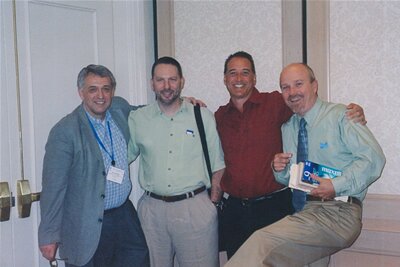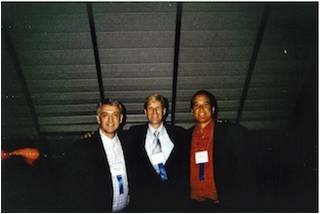| Research & Training: Teaching the Psychology of Men APA Workshop |
|
Graduate Student Scholarships To Be Offered for Teaching the Psychology of Men Continuing Education Program at the APA Washington D.C. Convention
Teaching the Psychology of Men will be a Continuing Education Program during the APA Convention in Washington , D.C. Eleven scholarships will be awarded to graduate students who want to attend the workshop free of charge.
The purpose of this introductory workshop will be to assist psychologists in developing course work on the psychology of men using the theoretical and empirical literature on men and masculinity. Participants will learn basic knowledge on how to create a psychology of men course or how to infuse this content into existing courses on gender or the psychology of women. Each presenter will share their syllabi, reading materials, class manuals, evaluation processes, and other resources. The workshop will discuss pedagogical processes such as traditional lecturing, psychoeducational techniques, group discussion approaches, use of video media, student assessment techniques, managing classroom problems, and the infusion of diversity and multiculturalism as critical content.
The goals of the workshop are to help psychologists:
The teaching faculty for the workshop include: James M. O'Neil, Ph.D, University of Connecticut, Storrs, CT; Christopher Kilmartin, Ph.D, Mary Washington University, Fredericksburg, VA; James Mahalik, Boston College, Chestnut Hill, MA.
Information about the graduate student scholarships, how to apply, criteria for selections, and the deadline date can be obtained by emailing Jim O’Neil, Chair, Committee on Teaching the Psychology of Men, at .
Registration For APA Continuing Education Programs Begins April 15, 2011: Call 1-, ext. 5991 Online Registration at apa.org/ce
|
|
How the Teaching of the Psychology of Men Committee and Workshop Came Into Existence
Jim O’Neil, Ph.D. Chair
Michael Addis, Ph.D.
Chris Kilmartin,Ph.D.
Jim Mahalik, Ph.D.
We also requested that a Committee on the Teaching of the Psychology of Men be established in Division 51. During the Hawaii Convention, the Executive Board of Division 51, voted to establish a permanent committee to promote the development of the Teaching of the Psychology of Men.
NEED AND RATIONALE FOR TEACHING THE PSYCHOLGY OF MEN The teaching of the psychology of men relates to critical social issues of great concern to men, women, and families including boy’s and men’s development across the life-span, issues of multiculturalism and sexual orientation, educational and school problems, violence in society, fathering, men’s health and others. Thus, the teaching of the psychology of men is central to psychology, yet one of the least developed areas in psychology (O’Neil, 2001). There is a need for formal instruction on how to teach the psychology of men. This need has been expressed by numerous divisions of APA including Division 51, 35, 17, & 43. Very limited direct instruction has been offered by APA related to teaching the psychology of men. Additionally, we believe that the teaching the psychology of men will be a growing areas over the next decade; just like the teaching of the psychology of women was in the 1980’s and 1990’s.
Furthermore, there is evidence that psychology of men is an emerging growth area (Addis & Mahalik, 2003; Smiler, 2004). This growth is documented by Smiler (2004) who found that from 1985-1989, only one publication using the term “masculinities” was found in PsychInfo, but from the period of 1995-1999, over 70 publications were found using this term. There will be a continuing need to educate psychologists on how to translate this emerging knowledge to undergraduate students, graduate students, and the general public.
TEACHING THE PSYCHOLOGY OF MEN CONTINUING EDUCATION WORKSHOP DESCRIPTION Below is the description of the 4-hour “Teaching the Psychology of Men Workshop” presented annually at the APA convention. We hope that you will consider enrolling in the future.
GOALS: This workshop is designed to help you:
DESCRIPTION OF THE WORKSHOP CONTENT The purpose of this workshop is to assist psychologists in developing course work on the psychology of men based using the theoretical and empirical literature on men and masculinity. The workshop provides basic knowledge on how to create a psychology of men course or how to infuse this content into existing courses on gender or the psychology of women (O’Neil, 1995; Russo, 1996). The workshop is rich with information on how to teach the psychology of men and also highly interactive to allow participants to ask questions, make comments, and interact with the instructors. There has been very little information on how to teach the psychology of men. Therefore, the workshop provides a rationale for the teaching the psychology of men, using the emerging scholarship in this area (Addis & Mahalik, 2003; Cohen, 2001; Kilmartin, 2000, 2001; Kimmel & Messner, 1998; Levant & Pollack, 1995).
Participants learn a rationale for teaching the psychology of men that explains this discipline as an expanding field, that intersects with the psychology of women and Women Studies, and relates to critical social issues such as societal and family violence, effective fathering, homophobia, and men’s and physical and mental health. Each presenter discusses how to develop and implement courses in the psychology of men and share their syllabi, reading materials, evaluation processes, and other resources. Abundant handouts of syllabi, class manuals, and teaching resources are disseminated. The workshop focuses on pedagogical approaches such as traditional lecturing, psychoeducational techniques, group discussion approaches, and the infusion of diversity and multiculturalism as critical content areas (Landrine, 1995; Madden & Hyde, 1998). Important process issues in teaching the psychology of men are delineated (Kilmartin, 2000; O’Neil, 2001; Urschel, 1999). These processes include norm setting, expectancy setting, conflict management, data gathering, self-assessments, group work, “journaling”, stereotyping, and working with resistance and defensiveness as part of the learning process. Brief examples of video media and self-assessment exercises are shared with the participants. Another major area addressed in the workshop is how to manage the problems/dilemmas that occur when teaching the psychology of men. Some of the problems addressed are: 1) how to enroll men, 2) sexism and heterosexism in the classroom, 3) “male bashing” and women’s anger at men, 4) the merits and problems with professor self-disclosure, 5) integrating research into courses. The instructors personally share their struggles and successes when teaching the psychology of men and encourage participants to share their own experiences and insights through an interactive dialogue.
EXAMPLE OF PAST WORKSHOP SCHEDULE:
FRAMEWORK TO TEACH THE PSYCHOLOGY OF MEN: WHAT ARE THE CRITICAL ISSUES?
There is very little information in the literature on how to teach the psychology of men. Therefore, numerous issues need to be discussed if the discipline is to develop and have impact in psychology and the greater society. Given this lack of conceptualization, an initial conceptual paradigm (See diagram above) was created that captured some of the critical issues in teaching the psychology of men. The initial paradigm included the following pedagogical areas: 1) Rationale and need for teaching the psychology of men; 2) teaching goals, 3) course content from psychology, 4) course content from outside psychology, 5) process issues including psychoeducation, writing assignments, journaling, interviews, and incorporating empirical research into courses, 6) infusing the course with multiculturalism and diversity, 7) use of media, psychological biographies, and self assessment exercises and checklists, 8) Dilemmas, problems, resistance, conflict, and defensiveness in the classroom, 9) classroom solutions to problems, 10) unanswered questions, 11) Teaching outside the classroom in the community. These eleven areas are presented as one way to conceptualize teaching the psychology of men. We emphasize many of these areas as we described our courses’ content and processes
9:00 - 9:30 - Presentation 1 Chris Kilmartin, University of Mary Washington 10:45 - 11:15 - Presentation 4 – Jim O’Neil, University of Connecticut Debriefing Lunch for Presenters
Reference and Emerging Reading List Addis, M. (2004) Teaching an advanced undergraduate and graduate level seminar in the psychology of men and masculinity. SPSMM Bulletin, 10, 47-53.
Addis, M. E., & Mahalik, J.R. (2003). Men, masculinity, and the context of help seeking. American Psychologist, 58, 5-14.
Brooks, G.R. & Good, G.E. (Eds., 2001) The new handbook of psychotherapy and counseling with men: A comprehensive guide to settings, problems, and treatment approaches. San Francisco: Jossey-Bass.
Cochran, S.V. & Rabinowitz, F.E. Men and Depression: Clinical and empirical perspectives. San Diego, CA: Academic Press.
Cohen, T.F. (2001). Men and masculinity: A text reader. Belmont, CA.: Wadsworth-Thomson Learning.
Gilmore, D.D. (1990). Manhood in the making: Cultural concepts of masculinity. New Haven, CT: Yale
Kilmartin, C. T. (2007). The masculine self. 3rd Edition, Cornwall-on-Hudson, New York: Sloan Publishing.
Kilmartin, C.T. (2001). Sexual assault in context: Teaching college men about gender. Holmes Beach, FL: Learning Publications.
Kilmartin, C. T. (2004). Exposing the default options by teaching men’s studies. SPSMM Bulletin, 10, 29-35.
Kimmel, M.S. & Messner, M.A. (Eds., 1998), Men’s Lives. Needham Heights, MA: Allyn and Bacon.
Landrine, H. (Ed., 1995) Bridging cultural diversity to feminist psychology: Theory, research, and practice. Washington, D.C.: American Psychological Association.
Levant, R.F (1992). The Society for the Psychological Study of Men and Masculinity. The Journal of Men’s Studies, 1, 75-76.
Levant, R.F. & Pollack, W.S. (Eds., 1995). A new psychology of men. New York: Basic Books
Lips, H. (2001). Sex and gender: An introduction (4th ed.) Mountain View, CA: Mayfield.
Madden, M.E. & Hyde, J.H. (Eds. 1998). Integrating gender and ethnicity into psychology courses. Psychology of Women Quarterly, 22, 1-130.
Mahalik, J.R. (2004). Teaching the psychology of men and masculinity. SPSMM Bulletin, 10, 53-71.
O’Neil, J.M. (1995) The gender role journey workshop: Exploring sexism and gender role conflict in a coeduational setting. In M. Addronico (Ed.) Men in groups: Insights, interventions, psychoeducational work. Washington, D.C.: APA Books.
O’Neil, J.M. (2001). Promoting men’s growth and development: Teaching the new psychology of men using psychoeducational philosophy and interventions. In G. R. Brooks & G.E. Good (Eds.) The new handbook of psychotherapy and counseling with men: A comprehensive guide to settings, problems, and treatment approaches. San Francisco, CA.: Jossey-Bass.
O’Neil, J.M. (2004) Teaching the psychology of men using psychoeducational principles, SPSMM Bulletin, 10, 36-47.
O’Neil, J.M., Addis, M., Kilmartin, C., Mahalik, J. (2004) Teaching the psychology of men: A potential growth area for psychology and Division 51 – A report from the APA Honolulu convention. SPSMM Bulletin, 10, 1, 21-29.
Pleck, J.H. (1981) The myth of masculinity. Cambridge, MA.: MIT Press.
Rabinowitz, F.E., & Cochran, S.V. (2002). Deepening psychotherapy with men. Washington, D.C.: American Psychological Association.
Russo, N.F. (1996). Masculinity, male roles, and the future of Feminist psychology. Psychology of Women Quarterly, 20, 1-2.
Smiler, A.P. (2004) Thirty years after the discovery of gender: Psychological concepts and measures Sex Roles, 50, 15-26.
Urschel, J.K. (1999). Pedagogical issues and approaches encountered in a psychology of men course. Journal of Men’s Studies, 8, 1-10.
Student Scholarships to Teaching the Psychology of Men Continuing Education Workshops
The Committee on Teaching of the Psychology of Men of Division 51 offers Continuing Education Workshop on “Teaching the Psychology of Men” at APA Conventions. The committee uses their $400.00 stipend that APA pays presenters and $300.00 given annually by SPSMM to offer seven scholarships for graduate students to attend the workshop. Graduate students who want to apply for these scholarships follow the instructions below:
Scholarships are awarded using the following criteria: 1) order of receiving the request for the scholarship, 2) student membership in APA and/or SPSMM, 3) year of masters or doctoral degree program, 3) any supporting information from advisors, mentors, or colleagues. Candidates for the scholarship should have their applications in by June 15. Selections for the scholarships will be finalized in late June.
Presenters after 1st Teaching the Psychology of Men Workshop (L to R) Jim O’Neil, Michael Addis, Chris Kilmartin
Presenters after 2nd Teaching the Psychology of Men Workshop (L to R) Jim Mahalik, Chris Kilmartin, Jim O’Neil, Michael Addis, & Fred Rabinowitz
The Committee on the Teaching the Psychology of Men and presenters (L to R) Jim O’Neil, Michael Addis, Chris Kilmartin, Jim Mahalik
Presenters after 6th Annual Teaching the Psychology of Men Workshop (L to R) Jim O’Neil, Mark Kiselica, & Chris Kilmartin
Presenters after 7th Annual Teaching the Psychology of Men Workshop (L to R) Michael Addis, Chris Kilmartin, Jim O’Neil, & Mark Kiselica |






